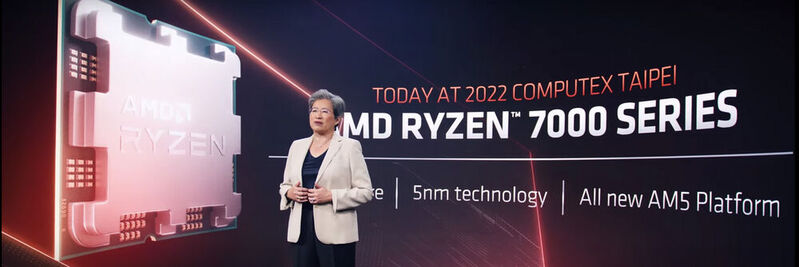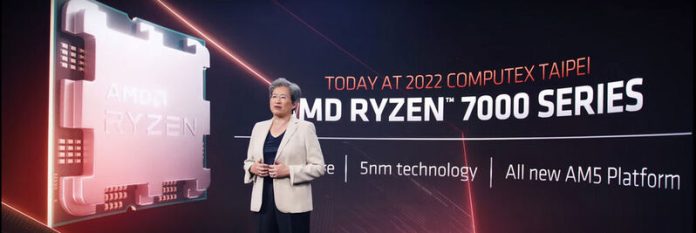AMD Ryzen 7000
Zen-4 processor with DDR5 and PCIe 5.0
Related providers
At Computex, AMD CEO Dr. Lisa Su raised the curtain a little on the upcoming Ryzen 7000 processor. It is now on par with Intel’s Alder Lake with DDR5 and PCIe Gen5, but should deliver significantly higher performance.

(Picture: AMD )
At the Computex keynote, AMD revealed some more details about the upcoming Ryzen 7000 processor for desktop PCs, which should be launched later this year. The CPU, codenamed Raphael, will be AMD’s first desktop processor with Zen 4 microarchitecture. The manufacturer has cut off a number of old pigtails: Ryzen 7000 sits on the new AM5 socket with LGA contacts for better signal quality instead of the usual pins. In addition, it now supports DDR5, but exclusively, as well as PCI-Express 5.0, similar to Intel’s Alder Lake. In contrast to Intel’s Alder Lake desktop CPUs, the Ryzen 7000 supports up to 24 lanes instead of only 16. This means that it can also connect up to two M.2 SSDs via the fast interface in parallel to upcoming PCIe Gen5 graphics cards.
The new CPU is now manufactured entirely at TSMC. So far, the I/O chiplet came from Globalfoundries. The compute dies are manufactured in a 5 nm process, the new I/O die in the N6 process. The finer structures not only allow a lower power consumption compared to the previous 12 nm module, but also the integration of an RDNA2 graphics unit, which will support up to four displays.
Higher clock speed and larger L2 cache
In the case of compute-this is not quite as big a jump from 7 to 5 nm, but it allows clock speeds of up to 5.5 GHz in turbo boost and also a level 2 cache doubled to one MB per core. AMD did not reveal at the Computex presentation whether there should be more than the current maximum of 16 cores per CPU. However, the new Zen-4 CPU is expected to increase performance per core by 15 percent compared to Zen 3. And with 16 active cores, it should even surpass the performance of a Core i9-12900K by 30 percent. The Intel CPU with its hybrid architecture also has only eight fast P-cores with 16 threads and another eight economical but slower e-cores without hyperthreading. The AM5 platform is designed for up to 170 watts of TDP. AMD did not mention whether the new CPUs also exhaust this limit.
Three new chipsets
AMD also announced three matching chipsets at Computex. The top models among the AM5 motherboards will be based on the X670 Extreme, which basically supports PCIe 5.0 for graphics cards and SSDs. For boards with X670, the PCIe 5.0 lanes for graphics cards are only optional, but the first M.2 slot for SSDs is basically connected via PCIe 5.0. With the B650 for cheaper mainstream boards, the faster PCIe connection is basically only available for mass storage. For graphics cards, only PCIe 4.0 is supported as an interface to the processor.
:quality(80)/images.vogel.de/vogelonline/bdb/1940200/1940280/original.jpg)
(ID:48364490)

